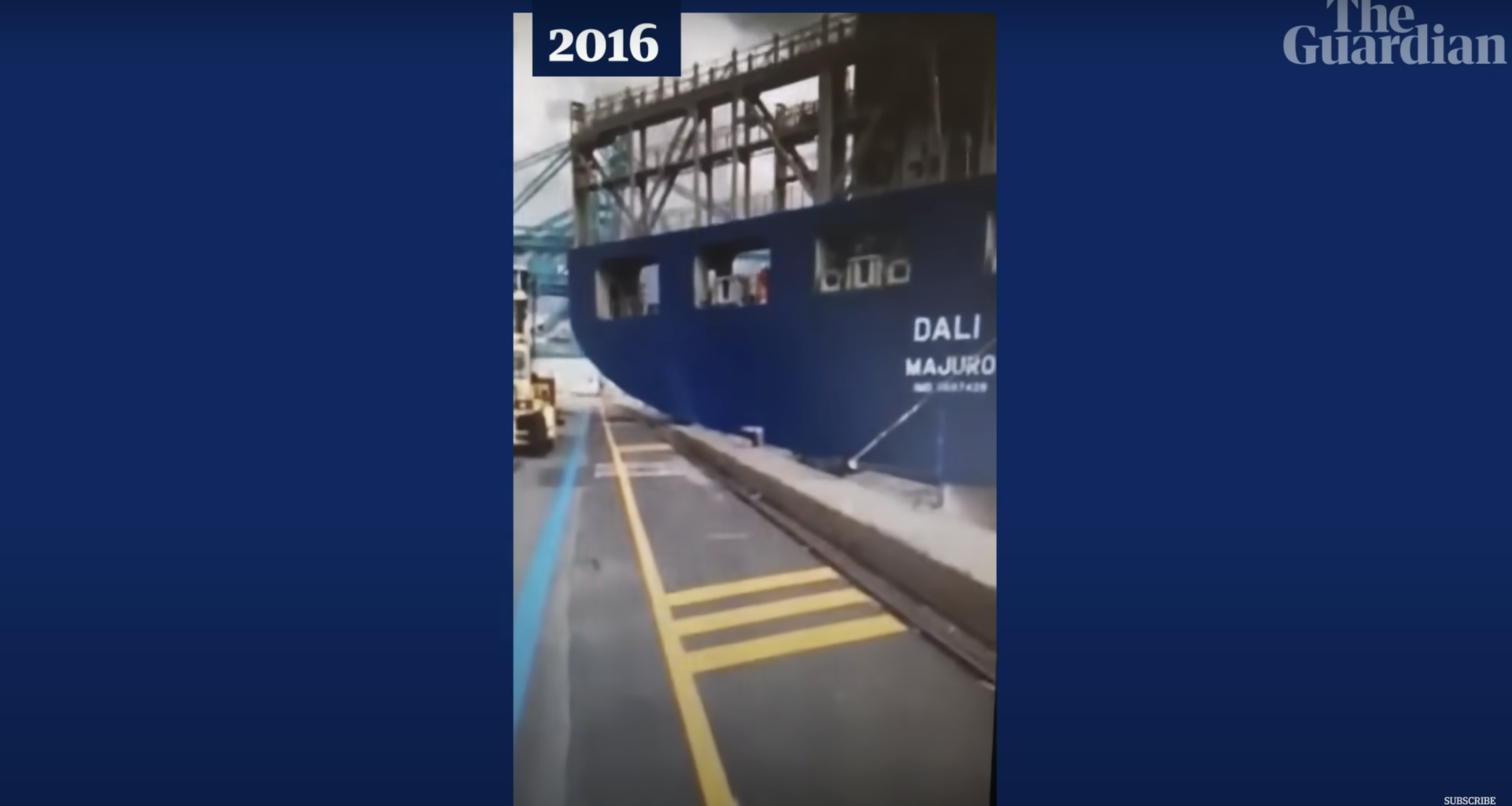The container ship crashing into Baltimore Bridge, 2024 | Another vessel involved in the Antwerp Accident, 2016 | Source: Getty Images | YouTube/@guardiannews
- In a startling disclosure, the cargo ship Dali, infamous for its recent collision with Baltimore’s Francis Scott Key Bridge, was previously embroiled in a maritime accident in Antwerp, Belgium, in 2016.
- This revelation ties the vessel’s operational history to two significant mishaps, underscoring persistent concerns over maritime safety and ship seaworthiness.
Advertisement
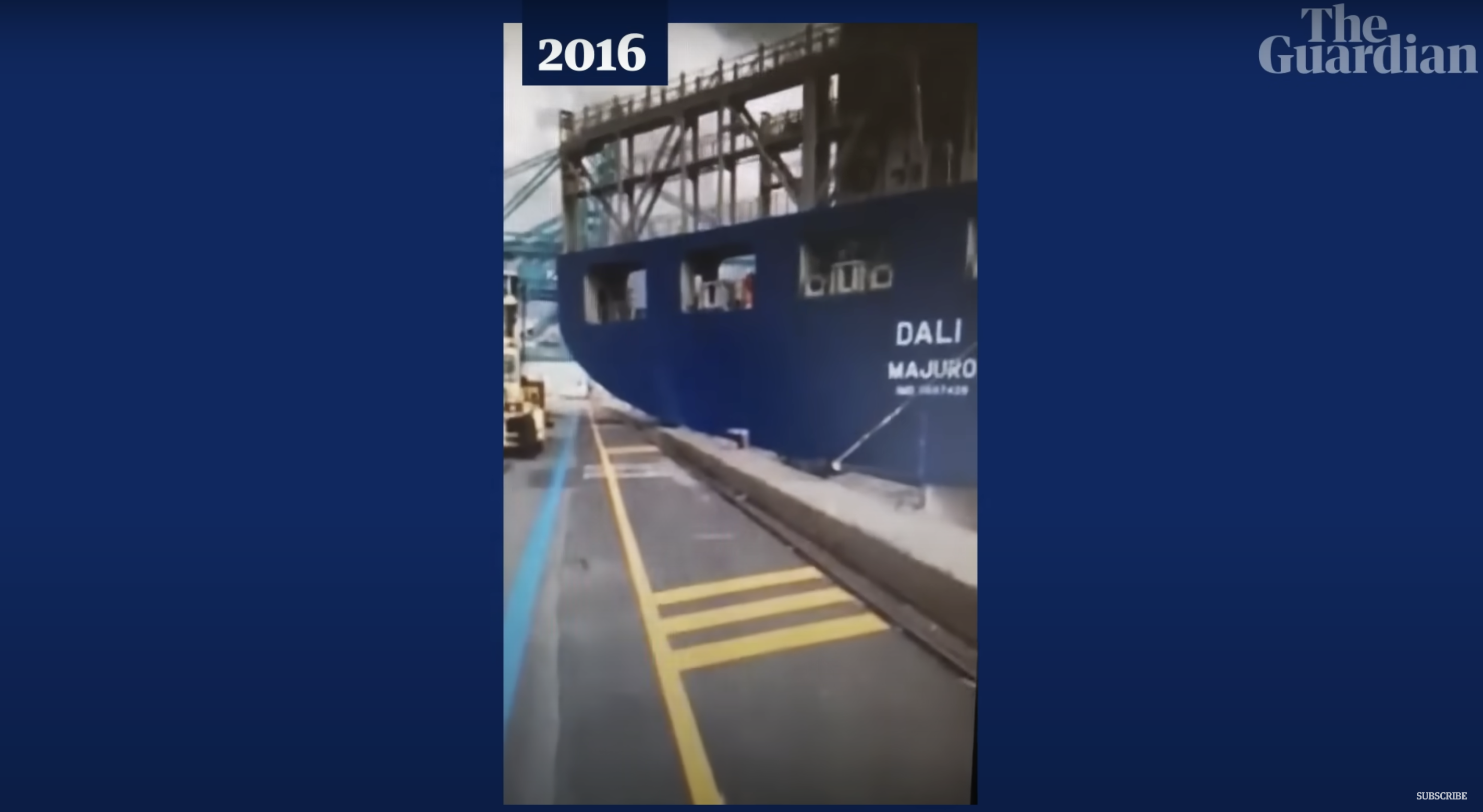
A photo of the container ship standing on the port of Antwerp, Belgium, as seen in a video dated March 26, 2024 | Source: YouTube/guardiannews
On July 11, 2016, the Singapore-flagged Dali collided with a quay in the Port of Antwerp while attempting to depart the North Sea Container Terminal. The accident was attributed to an oversight by the ship’s master and pilot, despite favorable weather conditions.
This collision was not without consequence: it resulted in “sufficient damages” to the ship’s stern while the dock suffered serious structural harm. Fortunately, there were no injuries reported, nor was there any oil spill, mitigating the potential for environmental damage.
In the aftermath of the incident, an inspection unveiled that the Dali had sustained “hull damage impairing its seaworthiness,” a finding disclosed through Equasis, a widely referenced shipping industry database. This assessment led to the ship being detained at the port for an extended duration to undergo repairs.
Advertisement

A photo of the container ship’s bow swinging around and damaging several meters of the hull, as seen in a video dated March 26, 2024 | Source: YouTube/guardiannews
Such procedures align with maritime protocol, which mandates thorough investigation and certification of a ship’s safety before it can resume operations. A spokesperson for the Antwerp port emphasized, “As a general rule, these accidents are investigated and ships are only allowed to leave after experts have determined it is safe for them to do so.”
Despite the measures taken post-Antwerp accident, the Dali’s involvement in the recent Baltimore Bridge collapse on Tuesday, March 26, raises critical questions about the effectiveness of maritime safety inspections and the enforcement of regulations intended to prevent such incidents.
Constructed in 2015 by Hyundai Heavy Industries, the Dali stands as a colossal entity in maritime logistics, measuring 948 feet in length and nearly 164 feet in width. Its capacity to carry about 111,000 tonnes of cargo illustrates the scale at which it operates within the global shipping network.
Advertisement
This vessel, under the Singaporean flag at the time of the Baltimore incident, was en route from Baltimore to Colombo, Sri Lanka, highlighting its role in facilitating international trade.
The maritime disaster that unfolded on Baltimore’s horizon has sent ripples of concern through the community, bringing to light the vulnerabilities of modern infrastructure to unforeseen calamities.
At the heart of this tragedy is the Dali, a massive container ship whose fateful collision with the Francis Scott Key Bridge has prompted a thorough investigation into the incident’s underlying causes and consequences.
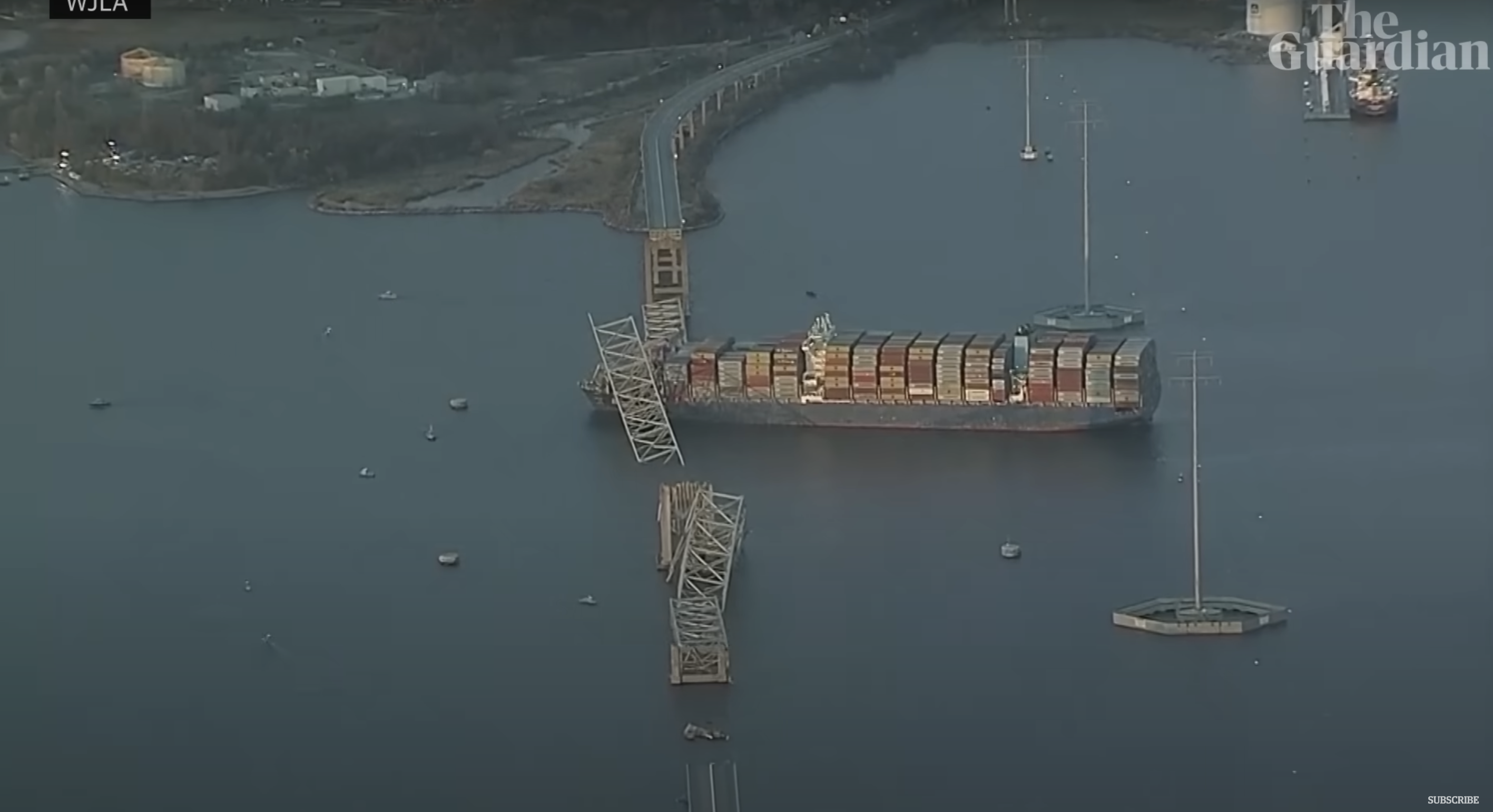
A photo of the container ship crashing into the Francis Scott Key Bridge in Baltimore, MD, as seen from a plane on March 26, 2024 | Source: YouTube/guardiannews
Advertisement
The ordeal began with a sudden and catastrophic loss of power aboard the Dali, a detail recovered from the ship’s data recorder which promises to offer crucial insights into the events leading up to the disaster.
This loss of power is suspected to have rendered the ship’s steering mechanisms inoperative, leaving the vessel adrift and on a collision course with disaster. Footage from the incident starkly illustrates the Dali’s perilous drift towards the bridge, showcasing the crew’s inability to alter its deadly trajectory.

Aerial shot of the Port of Baltimore at sunset. In the distance, the Key Bridge stretches across the river | Source: Getty Images
The impact of the collision was both immediate and devastating, with a significant portion of the 1.5-mile-long bridge succumbing to the force, collapsing into the waters of Baltimore Harbor.
Advertisement
This led to eight construction workers being plunged into the water below; while two were rescued on the day of the incident, the subsequent recovery efforts have thus far yielded two bodies, leaving four individuals still missing, presumed dead.
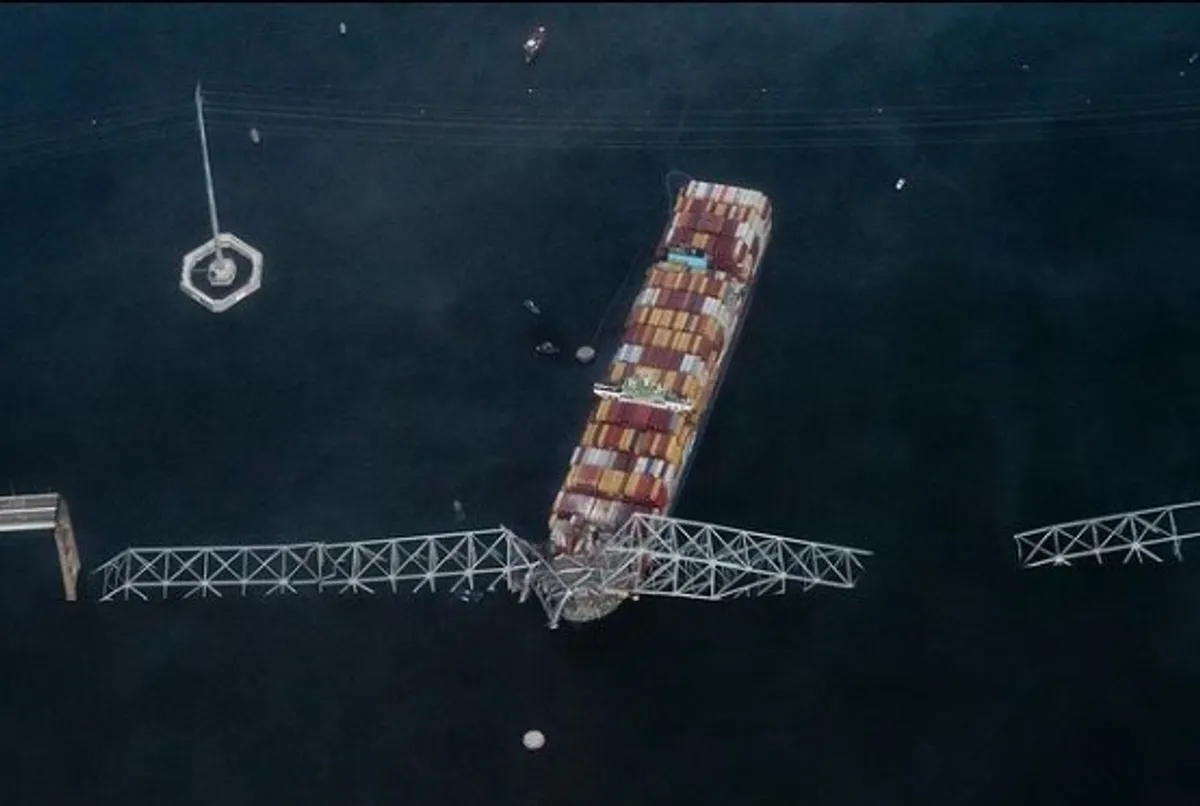
A photo where the container ship crashed into the Francis Scott Key Bridge in Baltimore, MD as seen from a plane on March 26, 2024 | Source: Instagram/vanhoutenphoto
In response to the Dali’s mayday alert, local police officers promptly initiated traffic control measures on the bridge, a decisive action that undoubtedly prevented further casualties.
This swift response to the emergency, as captured in recordings of the service provided by Broadcastify, showcases the critical importance of prompt and effective communication in mitigating the impact of such disasters.
Advertisement
The Dali had departed the port around 1 a.m. local time, embarking on what was supposed to be a 28-day voyage, under the guidance of the Danish shipping company Maersk. Scheduled to arrive on April 22, the journey was tragically cut short, casting a shadow over the vessel’s operational integrity and the safety protocols in place.
The ongoing investigation, spearheaded by the National Transportation Safety Board (NTSB), is intensively examining the root causes of the power loss, including the possibility of contaminated fuel compromising the ship’s engines.
Advertisement
The ship’s data recorder, commonly known as the “black box,” akin to an aviation flight recorder, is expected to be instrumental in shedding light on the critical moments before the crash, offering potential answers to the many questions surrounding this incident.
The Dali’s momentary loss of propulsion, as reported by its owner Synergy Marine Pte Ltd to the Maritime and Port Authority of Singapore (MPA), suggests a brief but significant lapse in the ship’s operational capabilities. The MPA’s statement clarifies that this loss of propulsion led to the ship’s inability to maintain its course, culminating in the tragic collision.

The Baltimore bridge collapse, as seen in a photo dated March 27, 2024 | Source: Facebook/Jorge Ramírez-Tendencia – Corresponsal TN5 Danlí
According to recent reports emerging online, in the critical minutes before the collision, the pilot of the Dali, recognizing the perilous situation unfolding due to the loss of power, made a distress call for tugboat assistance.
Advertisement
This plea for help, captured in audio recordings from the ship’s black box, highlights the gravity of the situation faced by the crew as they struggled to regain control over the vessel. Despite these efforts, the powerless and unmaneuverable ship was on an irreversible path toward disaster.
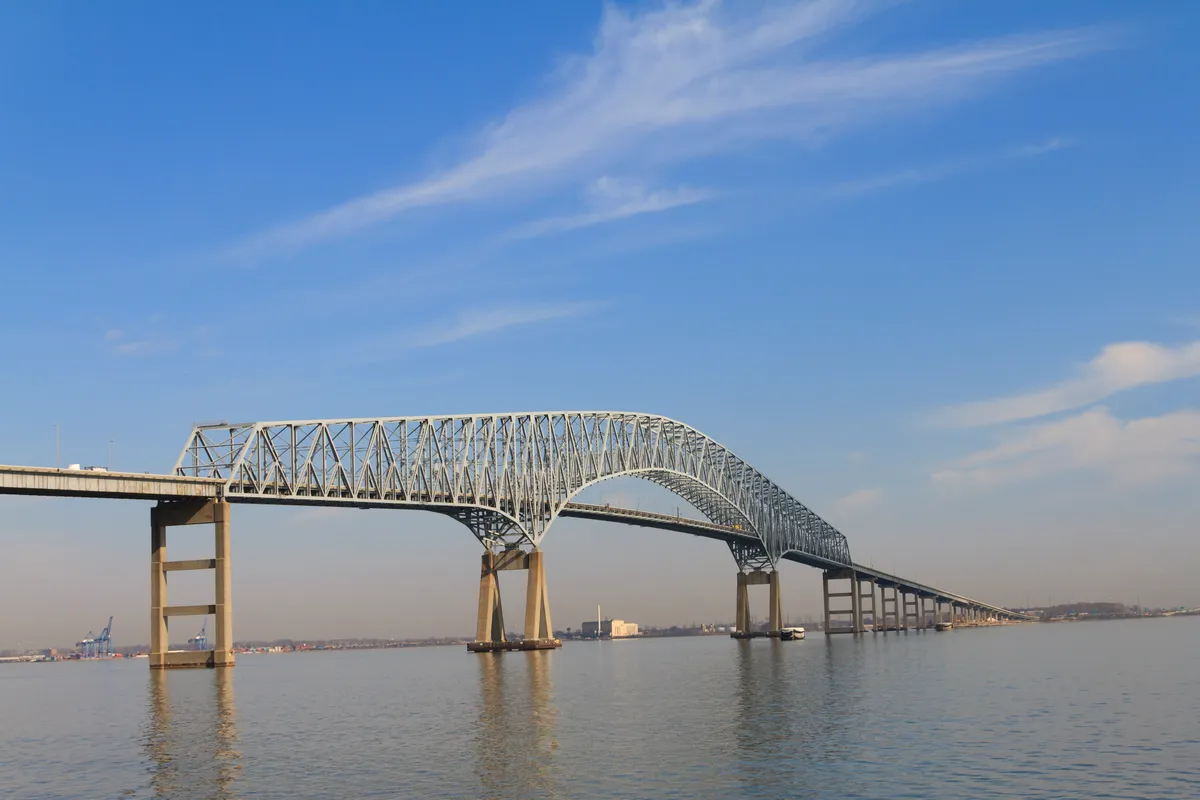
A picture of the Francis Scott Key Bridge before the cargo vessel collided with it on March 26, 2024 | Source: Getty Images
In the wake of the devastating collapse of Baltimore’s Francis Scott Key Bridge, a community reels, mourning the loss of life and grappling with the far-reaching implications of the disaster.
The tragedy has cast a spotlight on the individuals who found themselves at the epicenter of the calamity — six construction workers, whose aspirations, dreams, and commitments to their families have left an indelible mark on those who knew them.
Advertisement
Their presence on the bridge that fateful morning — engaged in the routine task of filling potholes — belied the extraordinary circumstances that would soon unfold, transforming an ordinary workday into a moment of profound loss.
Advertisement
Miguel, 49, had called Maryland home for over 19 years. Described as a dedicated family man, his sudden absence has left a void that words can scarcely fill.
The sentiment is echoed in the stories of his colleagues, including Maynor, a 38-year-old from Honduras, who had lived in the U.S. for the last 18 years, striving for a better life for his family, and launching his own maintenance business in pursuit of the American dream.
Advertisement
The victims were more than just workers; they were fathers, husbands, and dreamers. Alejandro, at 35, had made a life in Baltimore, originating from Mexico, while Dorlian, 26, hailed from Guatemala and lived in Dundalk, Maryland.
Their lives, interwoven with hopes and daily struggles, reflect the broader narrative of immigrants seeking better opportunities and contributing to the fabric of American society.
The tragedy has galvanized support from across the community, with crowdfunding campaigns raising significant sums for the victims’ families, aiming to provide a modicum of relief in the face of insurmountable grief. These efforts emphasize a collective desire to stand in solidarity with those affected, offering support and compassion in their time of need.
If you found this article informative, subscribe to our Facebook page for more insights and updates.
Meanwhile, you can click here to read more about the Baltimore Bridge crash victims.
Advertisement
Anomama

